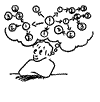|
| Overview | Change | Critique | Scenarios | Visions | Planning | Summary
|
CRITIQUE Critiquing the Impacts of Change
|
 |
||||||||||||||||
|
Finding and keeping an eye on change as it occurs around us is not sufficient for futures fluency. Critical to the task of inventing a better future is evaluating change. What effects cascade from ongoing change? What impacts do those effects have on our day-to-day life? Who has been newly advantaged or disadvantaged by the advent of change? What trade-offs might we face as a result of change? In order to critique the implications of change, we must first distinguish between unintended and intended change. The distinction rests on two concepts: intervention and responsibility. Unintended change is often described as "what happens if people take no action to intervene." But this characterization is both imprecise and incomplete. It is imprecise because people are always in action, and those actions continuously intervene in the fabric of reality. It is incomplete because lack of intention implies lack of planning and lack of responsibility: a more complete description of unintended change is "what happens 1) when people take no action to intervene, or 2) when people act without considering consequences and assuming responsibility." Unintended change is the combination of natural processes with those actions we take without thinking. Intended change is the product of conscious planning which assumes responsibilities for human interventions and their consequences. Second, we must distinguish between effects and impacts. "Effects" loosely encompasses all the linked changes that change itself causes: mapping the effects of change in essence looks not just at the result of the cue ball striking the racked balls, but at the subsequent results of the balls in motion as they rebound off the table walls and each other. "Impacts" loosely encompasses how all the players involved feel about the effects of the cue ball striking the racked balls. The "impacts" of change are our evaluations of all the effects of change -- and thus vary from person to person. As an example of these two distinctions, consider personal transportation. Increases in car ownership in the United States have outstripped increases in population. As a consequence, it takes longer to get to work, longer to find a place to park, and more money to pay for parking; air pollution has increased, car graveyards litter the land, and acres of discarded tires melt in perpetual smolder. These are all primary effects of the increase in the number of privately owned cars. Secondary effects include the creation of the fast-food/convenience store/gas station; gasoline credit cards; carphones, carfaxes, and trip computers; and "bedroom communities." To represent tertiary effects, I will offer only one example: the Exxon Valdez disaster. Car ownership is perceived by most people to enhance personal mobility and independence. Individual automobile ownership in the U.S. is so ingrained into the culture as to be considered a right: life, liberty, and happiness are pursued in a car. They are the intended effects of increased opportunities for personal car ownership. The primary, secondary, and tertiary effects offered as examples are unintended effects. People's reactions to the car graveyards or gridlock are the social impacts of those effects. Exploring
and mapping the tiers of effects that cascade from change
may focus on adding breadth or adding depth. That is, we can attempt
to think through the primary, secondary, and tertiary effects of
change, extending the series out to the limits of our patience or
imagination, or we can attempt to think through how the sets of
effects generated by several changes interact with each other. They
are both amenable to structured brainstorming. The first is often
accomplished via a futures technique called "futures wheels" and
the second via a qualitative form of a "cross-impact matrix." Figures
11 and 12, and Table 2, offer examples of these methods.
Futures Wheels
Table
2. Example Qualitative Cross-Impact Matrix: Combining Trend
Impacts
Lacking the time or resources for these approaches, a single individual can estimate social impacts by analogy, referring to previous research on similar situations. It is no more possible to map completely the effects and impacts of change than it is to predict the future. Any critique of the implications of change must acknowledge its unknowable complexity. More, our attempts to observe and map the patterns of change distort those patterns: social scientists also endanger Schrodinger's cat. |
|||||||||||||||||
> Essays > Futures Fluency > Chapter Five: Defining Futures Fluency:
| Overview | Change | Critique | Scenarios | Visions | Planning | Summary
| 15
February 2003. Email
IF. Copyright © 2003, Wendy L. Schultz All rights reserved. |
people have explored our infinite futures. (in addition to the 17,500+ visitors from 10/1/2001-12/15/2002). |













